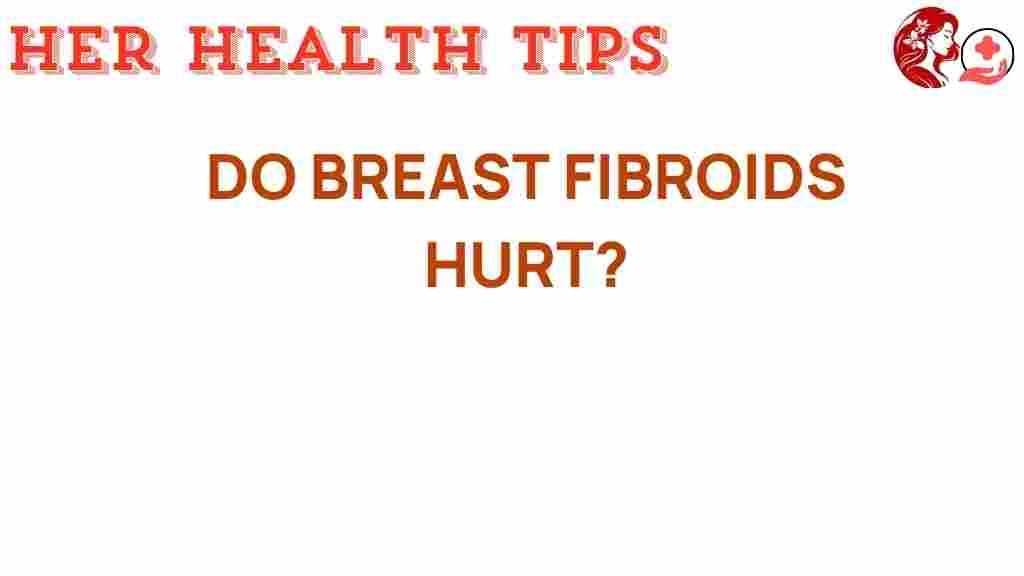Unraveling the Mystery: Do Breast Fibroids Hurt?
Breast fibroids, also known as fibrocystic changes, are a common concern among women, often leading to questions about their nature, symptoms, and whether they cause pain. Understanding breast fibroids and their implications for women’s health is crucial for making informed decisions regarding diagnosis and treatment. In this article, we will explore the symptoms, potential pain associated with breast fibroids, and how to manage and care for your breast health.
What Are Breast Fibroids?
Breast fibroids are non-cancerous growths that develop within the breast tissue. They can take the form of cysts, lumps, or areas of thickened tissue. These changes are typically referred to as fibrocystic breast changes, which are quite common and affect many women at some point in their lives.
Symptoms of Breast Fibroids
Understanding the symptoms of breast fibroids is essential for early detection and management. Symptoms may vary from person to person but commonly include:
- Breast tenderness or discomfort
- Lumps or masses that can be felt
- Swelling or fullness in the breasts
- Changes in breast texture
- Increased sensitivity before menstruation
While breast fibroids can cause discomfort, it is important to note that not all women will experience pain. Some may only notice changes during certain times of their menstrual cycle, while others may have persistent symptoms.
Do Breast Fibroids Hurt?
The question of whether breast fibroids hurt is a common concern. Many women report experiencing pain or discomfort associated with fibrocystic changes, particularly in relation to their menstrual cycle. The pain can vary in intensity and may be described as:
- Dull ache
- Sharp pain
- Throbbing sensation
Factors contributing to breast pain may include hormonal fluctuations, which can cause breast tissue to swell and become tender. However, it is essential to remember that pain is subjective; while some women may find fibroids painful, others may not experience any discomfort at all.
Diagnosis of Breast Fibroids
If you suspect that you have breast fibroids or are experiencing breast pain, it is crucial to seek a professional diagnosis. The diagnosis process typically involves:
- Clinical Breast Exam: A healthcare provider will examine your breasts for lumps or changes.
- Imaging Tests: Mammograms, ultrasounds, or MRI scans may be used to visualize the breast tissue and identify fibroids.
- Biopsy: In some cases, a small sample of breast tissue may be taken to rule out cancer.
Early diagnosis is key to managing symptoms and ensuring overall breast health.
Treatment for Breast Fibroids
When it comes to treating breast fibroids, options will vary based on the severity of symptoms and individual health needs. Treatment methods may include:
- Watchful Waiting: If symptoms are mild, your healthcare provider may suggest monitoring the fibroids over time.
- Over-the-Counter Pain Relief: Medications such as ibuprofen or acetaminophen can help alleviate discomfort.
- Hormonal Therapy: Birth control pills or hormone therapy may help regulate hormones and reduce symptoms.
- Surgery: In rare cases where fibroids are large or cause significant pain, surgical removal may be necessary.
It’s essential to discuss your symptoms and treatment options with a healthcare professional to determine the best course of action for your breast health.
Managing Symptoms and Breast Care
While breast fibroids are typically benign, managing symptoms and maintaining breast health is vital. Here are some tips for effective breast care:
- Wear Supportive Bras: A well-fitted bra can help alleviate discomfort and provide support.
- Apply Warm Compresses: Using a warm compress can soothe tender areas and reduce pain.
- Maintain a Healthy Diet: Eating a balanced diet rich in fruits, vegetables, and whole grains can support overall health.
- Stay Active: Regular exercise can help manage weight and reduce hormonal fluctuations.
- Stay Hydrated: Drinking plenty of water can help reduce bloating and tenderness.
Additionally, regular breast self-exams can help you become familiar with your breast tissue, making it easier to notice any changes or new lumps.
When to Seek Medical Advice
It’s important to consult a healthcare provider if you notice any of the following:
- New lumps that do not go away
- Changes in breast shape or size
- Persistent pain that does not improve with over-the-counter medication
- Discharge from the nipples
These signs may warrant further investigation to rule out other potential issues, including breast cancer.
Conclusion
In summary, breast fibroids and fibrocystic changes are common occurrences that many women experience throughout their lives. While some women may experience pain associated with these conditions, others may not. Understanding the symptoms, seeking proper diagnosis, and exploring treatment options are vital steps in managing breast health.
Remember to engage in proactive breast care, including regular self-exams and professional check-ups. If you have concerns about breast fibroids or experience persistent pain, do not hesitate to consult a healthcare provider. For more information on women’s health, resources such as Women’s Health Resource can provide valuable insights.
With the right knowledge and care, you can navigate the complexities of breast fibroids and maintain optimal breast health.
This article is in the category Conditions and created by HerHealthTips Team
